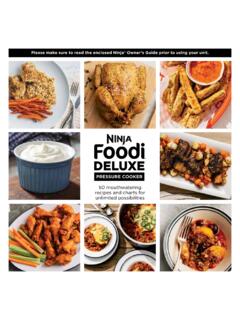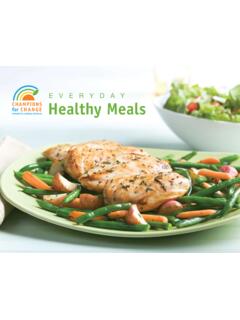Transcription of Affordable, tasty recipes – good for the whole family
1 Affordable, tasty recipes good for the whole familyA JOINT INITIATIVE BYCompiled by Heleen MeyerPhotography by Adriaan VorsterwHow healthily do you eat? ..p2 Guidelines for healthy eating ..p4 Planning healthy meals ..p6 Takeaways and eating out ..p8 Frequently asked questions ..p10 Shopping and cooking on a budget ..p12 Easy guide for reading food labels ..p13 RecipeswA bowl of soup ..p14wSalads and veggies ..p22wLunch and supper ..p34 Fish ..p35 Vegetarian ..p43 Chicken ..p50 Meat ..p60wSweet treats and desserts ..p70wSnacks, breads and baking ..p82 Everyday ingredients in your kitchen ..p92 Index ..p93 The recipes in this book wereselected from family favouritescontributed by people all overSouth Africa.
2 These have beenadaptedto follow the guide-lines of the Heart and StrokeFoundation South Africa. Re-member that healthy eating isimportant for the whole familyand not only for the personaffected by a lifestyle your childrento eathealthily from a young age toprotect them from chronicdi seases later in life. Healthyfood doesn t have to be expen-sive or bland and show you how to use aslittle fat, oil, salt and sugar aspossible and rather use herbs,lemon juice, salt-free spices andother seasonings to preparedeliciousfood. We want toencourage you and your familyto graduallymake changes tothe way you eat and cook.
3 Thiswill make a huge difference toyour to remember:1 tbsp stands for 1 tablespoon = 15 ml1 tsp stands for 1 teaspoon = 5 ml tsp = 2,5ml1 tsp = 5 ml2 tsp = 10 ml1 tbsp = 15 ml2 tbsp = 30 ml cup = 60 ml cup = 125 ml1 cup = 250 ml2 cups = 500 mlContentsFood is central to the identity of South meals the family meets around the holidays and high days we gather around thebraai and the potjie pot which reflect the diversityof our country. Food has many memories associatedwith it the soup that warms our bodies and oursouls, the dish for our homecomings, and therecipes that take us back to our can also be our enemy.
4 We are seeing rising levels of lifestyle diseasesin South Africa, with terrible impacts on our health heart disease, stroke,type two diabetes and cancers are all on the rise, due to our increasinglypoor diet. We all know that staying healthy can be difficult. We have busy schedules,and shrinking household budgets. Healthy foods recommended to us oftenseem unavailable and unaffordable, leaving us feeling inadequate. It can betime-consuming to make the journey to the supermarket and to prepare ameal, when fast food is closer to home. Can we afford to spend more on so-called healthy foods ? Do we have thetime to slave over a stove to make dishes that our families turn their nosesup at?
5 The truth is healthy eating doesn t have to be boring, expensive orcomplicated! It can be as simple as making small changes to your family sfavourite dishes. This recipe book shows how to make food that tastesgood, is simple to prepare and is easy on the pocket. By using everydayingredients, you too can prevent yourself and your families from thedangers of different lifestyle am passionate about making healthy living accessible to everyone inSouth Africa and increasing our understanding of the risk factors of seriousdiseases. It has so many implications for the future of our nation. This recipebook can show us how we can take responsibility for our own health, andhow to protect our families now and in the TutuForewordDO YOU USUALLY.
6 ?YES NOChoose wholewheat or brown bread and flour, rather than white bread orflour?Have at least 3 vegetables a day?Have at least 2 fresh fruit a day?Choose fat-free or low-fat dairy like milk, maas or yoghurt?Eat red meat (like mutton, beef or boerewors) less than 3 times a week?Include dried or tinned beans, split peas, lentils or soya in your meals at leasttwice a week?Remove all the visible fat from meat before you eat it?Remove the skin from chicken before cooking it?Avoid eating high-fat foods such as chips, viennas, polony or chocolate? Eat fish at least twice a week?Avoid eating takeaways or street foods like doughnuts, pies, vetkoek,samoosas, fried chips, fried chicken, gatsbies or kotas ?
7 Try to cook with less oil and avoid deep-frying foods?Avoid salty foods like polony, bacon, viennas, crisps, salty biscuits and high-salt sauces like soya or barbeque sauce?Avoid adding extra salt to your food at the table?Try to avoid adding high-salt ingredients like soup powders, stock cubes orsalty seasonings to your food?Choose healthier snacks like fruit, vegetables, low-fat or fat-free yoghurtbetween your meals?Use soft tub margarine for your bread, rather than butter or brick margarine?Avoid drinking sugary cold drinks or juices?Cooking from the healthily do you and your family eat?A healthy diet includes plenty of vegetables, fruit and high-fibrestarchy foods, and is low in fat (especially saturated fat), salt andsugar.
8 Take the quiz on the next page to see how healthily you andyour family are eating. Your results will show whether you need toimprove your eating habits. If you ticked No for any of the questions, your and/or your family sdiet can be improved. The more No answers you ticked, the moreunhealthy your diet is and the higher your risk of chronic diseasessuch as high blood pressure, diabetes, heart disease, stroke andcancer. You need to think about changing your diet to improve youroverall health. You can make a start by following the healthy eatingguidelines (pages 4-13) in this book and by preparing some of thedelicious you ticked Yes for some questions, you are making goodprogress, but you can still benefit by making more changes to youreating you ticked Yes every time well done!
9 You are well on your wayto preventing chronic diseases because you are choosing healthieroptions and avoiding the unhealthy foods eaten by many SouthAfricans. Carry on reading to learn more about healthy eating and why it isimportant for you and your family ..OPHealthy eating questionnaire adapted from Love my body love myself, Dr Marjanne Senekal, Cape Town, a varietyof types offood gives your body allthe nutrients it more colourful yourplate of food, the widerthe driedbeans, splitpeas, lentils orsoya at least twice aweek. They are a goodsource of protein, low infat and high in fibre. Youcan replace meat insome meals with thesefoods. Make high-fibre starchyfoods part ofmost meals.
10 Thesefoods can help you feelfuller for longer andlower your risk of de -veloping obesity, Bad fats can increaseyour cholesterol andblock your blood ves-sels, which can lead toa stroke or heart to include tinned orfresh fish as part of yourdiet at least twice aweek. Good examplesare pilchards, snoek,sardines or low-fatmilk, maas oryoghurt everyday. Dairy products arean excellent source ofcalcium. This can helpprotect your bones andhelp prevent high bloodpressure, diabetes, os-teoporosis and heartdisease. Good optionsare low-fat or fat-freedairy products and re-duced-fat disease and can-cer. Good examples arebrown or wholewheatbread, coarse maize(mealie) meal, oats andbrown rice. Try to eat 5vegetables andfruit every ber to eat veg-etables and fruit fromthe different colourgroups (red, green, yel-low and orange).






